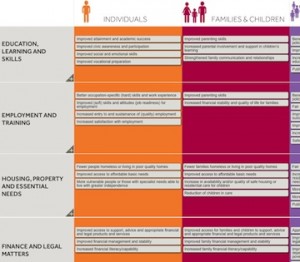One of the most difficult areas of social design is measuring impact. We are pretty good at measuring outputs — 100 people attend a seminar, 2000 widgets are distributed, or an upgrade to a public space attracts 45% more people to the space than before. But what is the longer term impact of these outputs?
For example, is social captial built when people meet new friends at events? Was health improved when more people ate lunch outside in the improved public space? and so on. If investments and design decisions are made on the basis of a social return, how can we measure it?
Today I want to point out the outcomes matrix developed by Big Society Capital, a social investement company in the UK. In this matrix you’ll find outcomes by category such as education, employment, housing, finance, health, criminal justice/public safety.
The desired outcomes are then offered in terms of individuals, families and children, and community and society. For example, under “mental health” for families and children, we find outcomes such as “more secure parent child relationships” and “an increase in shared decision making.” This matrix also unfolds with further detail in some categories.
We can picture how the indicators in this matrix could be applied to a design project, perhaps along side a more rigorous environmental ranking system such as LEED (building rating) or C2C (Cradle to Cradle product rating).
In design we also have arguments to make about how aesthetics affect social outcomes. For example, a well designed facility brings credibility that might lead to higher investment from sponsors. It brings more dignity to underserved populations. It elevates the profile of the client’s cause in the eyes of the public.
One difficulty of measuring outcomes is that they may occur months or years after any given design project is finished. Rarely is there scope to go back and look at outcomes at distant points in the future. Architects rarely even do that to determine if building energy efficiency performs as designed.
So a challenge is to define a feasible, meaningful range of metrics and then to build in scope to look at these metrics at the right time, which might mean a couple of years into the future.
How are you measuring social impact in your projects? Is it mostly intuitive? This question of metrics is something I discussed with design activists Blaine Merker (at Rebar) and Liz Ogbu. I reported these and other findings in the book Architecture & Design versus Consumerism.
________________________
If you’re interested, check out my Thursday Inspiration post on Big Data and Sustainable Design. Pass along this post to others who might be interested and subscribe (in the right margin) to get the monthly summary.
